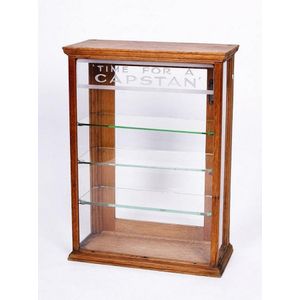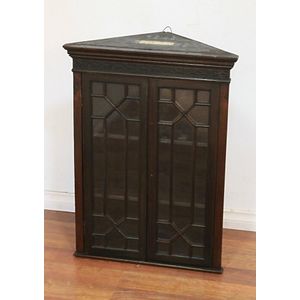Mahogany Cabinet with 28 Drawers and Brass Handle
You must be a subscriber, and be logged in to view price and dealer details.
Subscribe Now to view actual auction price for this item
When you subscribe, you have the option of setting the currency in which to display prices to $Au, $US, $NZ or Stg.
- Plinth - The square or rectangular base of a piece of cabinet furniture, often ornamented with moulding. The plinth may be separate, as in some wardrobes or presses, and act as the support for the carcase. In a false plinth, the moulded boards may be attached directly to the piece. Furniture with a plinth base usually does not have separate feet. The term derives from architecture where it denotes the base of a column or statue.
- Mahogany - Mahogany is a dense, close grained red-coloured timber from the West Indies and Central America. It was first imported into Europe in the the early 18th century and its use continued through the 19th century. It was popular for furniture making because of its strength, the wide boards available, the distinctive grain on some boards, termed flame mahogany and the rich warm colour of the timber when it was polished.. The "flame" was produced where a limb grew out from the trunk of the tree, and this timber was usually sliced into veneers for feature panels on doors, backs and cornices.
Some terms used to describe mahogany relate to the country from which it originally came, such as "Cuban" mahogany, "Honduras" mahogany etc. However unless the wood has been tested the names assigned are more a selling feature, rather than a true indication of the timber's origin. - Provenance - A term used to describe the provable history of an antique or work of art, and thus an additional aid to verifying its authenticity. Provenance can have an inflating effect on the price of an item, particularly if the provenance relates to the early settlement of Australia, a famous person, or royalty. Less significant are previous sales of the item through an auction house or dealer.
This item has been included into following indexes:
Visually similar items

A George IV rosewood side cabinet, circa 1825, the rectangular top with a gallery edged open display shelf, above two doors, each door inset with a brass grill and pleated silk lining enclosing shelves, above a plinth base, 132 cm high, 106.5 cm wide, 35.5

Late Victorian walnut glazed bookcase with circular plaque inscribed Lily from Mamma Sept 15th 1891, with key, 218 cm high, 118 cm long, 44 cm deep, wooden shelves

Capstan cigarette display cabinet inscribed on the top front 'Time for a Capstan'. Height 56 cm, width 38.5 cm, depth 18 cm

A Chippendale Revival mahogany two door miniature corner cabinet. 69 cm high, 50 cm long, 26 cm deep
